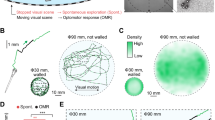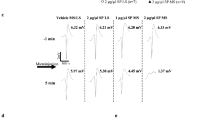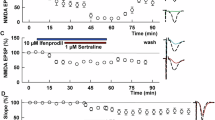Abstract
Antagonists of the substance P (SP) preferring neurokinin 1 receptor (NK1R) represent a promising novel class of drugs for the treatment of stress-related disorders such as depression and anxiety disorders; however, the involved neuronal pathways releasing SP in response to stressors are ill defined. By using in vivo microdialysis in combination with a highly sensitive and selective radioimmunoassay we found that exposure to forced swim stress increased SP release in the rat lateral septum (LS), a key area in processing emotions and stress responses. Acute administration of the selective NK1R antagonist L-822429 injected either systemically or locally into the LS reduced passive and facilitated active stress-coping strategies in the forced swim test. This effect seems to be mediated by enhanced intraseptal serotonergic transmission via serotonin (5-HT)1A receptors since NK1R blockade reversed the swim stress-induced decrease to an increase in extracellular 5-HT efflux, and furthermore the behavioral effects of L-822429 were blocked by intraseptal 5-HT1A receptor antagonism. A direct heterosynaptic regulation by NK1R on 5-HT release from serotonergic fibers was ruled out by immunocytochemistry at the light and electron microscopic level indicating involvement of GABAergic interneuron(s) in this interaction. Taken together, our data identify the LS as a critical brain area for the involvement of SP transmission in the modulation of stress responses and demonstrate that NK1R blockade can elicit a functionally significant facilitatory effect on 5-HT transmission, which does not necessarily involve the previously proposed interaction with neuronal firing at the cell body level of raphe neurons.
Similar content being viewed by others
Log in or create a free account to read this content
Gain free access to this article, as well as selected content from this journal and more on nature.com
or
References
Adell A (2004). Antidepressant properties of substance P antagonists: relationship to monoaminergic mechanisms? Curr Drug Targets CNS Neurol Disord 3: 113–121.
Bilkei-Gorzo A, Racz I, Michel K, Zimmer A (2002). Diminished anxiety- and depression-related behaviors in mice with selective deletion of the Tac1 gene. J Neurosci 22: 10046–10052.
Blier P, Gobbi G, Haddjeri N, Santarelli L, Mathew G, Hen R (2004). Impact of substance P receptor antagonism on the serotonin and norepinephrine systems: relevance to the antidepressant/anxiolytic response. J Psychiatry Neurosci 29: 208–218.
Bondi CO, Barrera G, Lapiz MD, Bedard T, Mahan A, Morilak DA (2007). Noradrenergic facilitation of shock-probe defensive burying in lateral septum of rats, and modulation by chronic treatment with desipramine. Prog Neuropsychopharmacol Biol Psychiatry 31: 482–495.
Burgdorf J, Panksepp J (2006). The neurobiology of positive emotions. Neurosci Biobehav Rev 30: 173–187.
Chen LW, Wei LC, Liu HL, Qiu Y, Chan YS (2001). Cholinergic neurons expressing substance P receptor (NK(1)) in the basal forebrain of the rat: a double immunocytochemical study. Brain Res 904: 161–166.
Chenu F, Guiard BP, Bourin M, Gardier AM (2006). Antidepressant-like activity of selective serotonin reuptake inhibitors combined with a NK1 receptor antagonist in the mouse forced swimming test. Behav Brain Res 172: 256–263.
Conley RK, Cumberbatch MJ, Mason GS, Williamson DJ, Harrison T, Locker K et al (2002). Substance P (neurokinin 1) receptor antagonists enhance dorsal raphe neuronal activity. J Neurosci 22: 7730–7736.
Corti C, Aldegheri L, Somogyi P, Ferraguti F (2002). Distribution and synaptic localisation of the metabotropic glutamate receptor 4 (mGluR4) in the rodent CNS. Neuroscience 110: 403–420.
Cryan JF, Valentino RJ, Lucki I (2005). Assessing substrates underlying the behavioral effects of antidepressants using the modified rat forced swimming test. Neurosci Biobehav Rev 29: 547–569.
Culman J, Unger T (1995). Central tachykinins: mediators of defence reaction and stress reactions. Can J Physiol Pharmacol 73: 885–891.
Dableh LJ, Yashpal K, Rochford J, Henry JL (2005). Antidepressant-like effects of neurokinin receptor antagonists in the forced swim test in the rat. Eur J Pharmacol 507: 99–105.
David DJ, Froger N, Guiard B, Przybylski C, Jego G, Boni C et al (2004). Serotonin transporter in substance P (neurokinin 1) receptor knock-out mice. Eur J Pharmacol 492: 41–48.
De Vry J, Schreiber R, Melon C, Dalmus M, Jentzsch KR (2004). 5-HT1A receptors are differentially involved in the anxiolytic- and antidepressant-like effects of 8-OH-DPAT and fluoxetine in the rat. Eur Neuropsychopharmacol 14: 487–495.
Doutrelant O, Poulain P, Carette B (1993). Comparative distribution of calbindin and Met-enkephalin immunoreactivities in the guinea-pig lateral septum, with reference to electrophysiologically characterized neurons in the mediolateral part. Brain Res 615: 335–341.
Ebner K, Rupniak NM, Saria A, Singewald N (2004). Substance P in the medial amygdala: emotional stress-sensitive release and modulation of anxiety-related behavior in rats. Proc Natl Acad Sci USA 101: 4280–4285.
Ebner K, Singewald N (2006). The role of substance P in stress and anxiety responses. Amino Acids 31: 251–272.
Ferraguti F, Cobden P, Pollard M, Cope D, Shigemoto R, Watanabe M et al (2004). Immunolocalization of metabotropic glutamate receptor 1alpha (mGluR1alpha) in distinct classes of interneuron in the CA1 region of the rat hippocampus. Hippocampus 14: 193–215.
Froger N, Gardier AM, Moratalla R, Alberti I, Lena I, Boni C et al (2001). 5-hydroxytryptamine (5-HT)1A autoreceptor adaptive changes in substance P (neurokinin 1) receptor knock-out mice mimic antidepressant-induced desensitization. J Neurosci 21: 8188–8197.
Furmark T, Appel L, Michelgard A, Wahlstedt K, Ahs F, Zancan S et al (2005). Cerebral blood flow changes after treatment of social phobia with the neurokinin-1 antagonist GR205171, citalopram, or placebo. Biol Psychiatry 58: 132–142.
Gall C, Moore RY (1984). Distribution of enkephalin, substance P, tyrosine hydroxylase, and 5-hydroxytryptamine immunoreactivity in the septal region of the rat. J Comp Neurol 225: 212–227.
Gavioli EC, Canteras NS, De Lima TC (1999). Anxiogenic-like effect induced by substance P injected into the lateral septal nucleus. NeuroReport 10: 3399–3403.
Gavioli EC, Canteras NS, De Lima TC (2002). The role of lateral septal NK1 receptors in mediating anxiogenic effects induced by intracerebroventricular injection of substance P. Behav Brain Res 134: 411–415.
Gobbi G, Blier P (2005). Effect of neurokinin-1 receptor antagonists on serotonergic, noradrenergic and hippocampal neurons: comparison with antidepressant drugs. Peptides 26: 1383–1393.
Guiard BP, Froger N, Hamon M, Gardier AM, Lanfumey L (2005). Sustained pharmacological blockade of NK1 substance P receptors causes functional desensitization of dorsal raphe 5-HT 1A autoreceptors in mice. J Neurochem 95: 1713–1723.
Guiard BP, Lanfumey L, Gardier AM (2006). Microdialysis approach to study serotonin outflow in mice following selective serotonin reuptake inhibitors and substance P (neurokinin 1) receptor antagonist administration: a review. Curr Drug Targets 7: 187–201.
Guiard BP, Przybylski C, Guilloux JP, Seif I, Froger N, De Felipe C et al (2004). Blockade of substance P (neurokinin 1) receptors enhances extracellular serotonin when combined with a selective serotonin reuptake inhibitor: an in vivo microdialysis study in mice. J Neurochem 89: 54–63.
Gustafson EL, Durkin MM, Bard JA, Zgombick J, Branchek TA (1996). A receptor autoradiographic and in situ hybridization analysis of the distribution of the 5-ht7 receptor in rat brain. Br J Pharmacol 117: 657–666.
Heinrichs SC, Menzaghi F, Pich EM, Baldwin HA, Rassnick S, Britton KT et al (1994). Anti-stress action of a corticotropin-releasing factor antagonist on behavioral reactivity to stressors of varying type and intensity. Neuropsychopharmacology 11: 179–186.
Herpfer I, Lieb K (2005). Substance P receptor antagonists in psychiatry: rationale for development and therapeutic potential. CNS Drugs 19: 275–293.
Hökfelt T, Kuteeva E, Stanic D, Ljungdahl A (2004). The histochemistry of tachykinin systems in the brain. In: Holzer P (ed). Tachykinins. Springer: Heidelberg. pp 63–120.
Hökfelt T, Pernow B, Wahren J (2001). Substance P: a pioneer amongst neuropeptides. J Intern Med 249: 27–40.
Keller M, Montgomery S, Ball W, Morrison M, Snavely D, Liu G et al (2005). Lack of efficacy of the substance P (neurokinin 1 receptor) antagonist aprepitant in the treatment of major depressive disorder. Biol Psychiatry 59: 216–223.
Kirby LG, Allen AR, Lucki I (1995). Regional differences in the effects of forced swimming on extracellular levels of 5-hydroxytryptamine and 5-hydroxyindoleacetic acid. Brain Res 682: 189–196.
Kirby LG, Lucki I (1997). Interaction between the forced swimming test and fluoxetine treatment on extracellular 5-hydroxytryptamine and 5-hydroxyindoleacetic acid in the rat. J Pharmacol Exp Ther 282: 967–976.
Kirby LG, Lucki I (1998). The effect of repeated exposure to forced swimming on extracellular levels of 5-hydroxytryptamine in the rat. Stress 2: 251–263.
Köhler C, Chan-Palay V, Steinbusch H (1982). The distribution and origin of serotonin-containing fibers in the septal area: a combined immunohistochemical and fluorescent retrograde tracing study in the rat. J Comp Neurol 209: 91–111.
Korte SM, De Boer SF (2003). A robust animal model of state anxiety: fear-potentiated behaviour in the elevated plus-maze. Eur J Pharmacol 463: 163–175.
Kramer MS, Cutler N, Feighner J, Shrivastava R, Carman J, Sramek JJ et al (1998). Distinct mechanism for antidepressant activity by blockade of central substance P receptors. Science 281: 1640–1645.
Kramer MS, Winokur A, Kelsey J, Preskorn SH, Rothschild AJ, Snavely D et al (2004). Demonstration of the efficacy and safety of a novel substance P (NK1) receptor antagonist in major depression. Neuropsychopharmacology 29: 385–392.
Landgraf R, Wotjak CT, Neumann ID, Engelmann M (1998). Release of vasopressin within the brain contributes to neuroendocrine and behavioral regulation. Progress Brain Res 119: 210–219.
Lanfumey L, Hamon M (2000). Central 5-HT1A receptors: regional distribution and functional characteristics. Nucl Med Biol 27: 429–435.
Lejeune F, Gobert A, Millan MJ (2002). The selective neurokinin (NK1) antagonist, GR205,171, stereospecifically enhances mesocortical dopaminergic transmission in the rat: a combined dialysis and electrophysiological study. Brain Res 935: 134–139.
Lejeune F, Gobert A, Millan MJ (2003). The neurokinin (NK1) antagonist, GR205,171, alters the influence of serotonin (5-HT) reuptake inhibitors (SSRI) on serotonergic neurones: a dual electrophysiological and dialysis analysis. Soc Neurosci Abstr 889: 22.
Lieb K, Fiebich BL, Herpfer I, Mantovani M, Loffler M, Feuerstein TJ (2005). No modulatory effect of neurokinin-1 receptor antagonists on serotonin uptake in human and rat brain synaptosomes. Eur Neuropsychopharmacol 15: 641–646.
Ljungdahl A, Hökfelt T, Nilsson G (1978). Distribution of substance P-like immunoreactivity in the central nervous system of the rat—I. Cell bodies and nerve terminals. Neuroscience 3: 861–943.
Malcangio M, Bowery NG (1999). Peptide autoreceptors: does an autoreceptor for substance P exist? Trends Pharmacol Sci 20: 405–407.
Martin P, Beninger RJ, Hamon M, Puech AJ (1990). Antidepressant-like action of 8-OH-DPAT, a 5-HT1A agonist, in the learned helplessness paradigm: evidence for a postsynaptic mechanism. Behav Brain Res 38: 135–144.
Maubach KA, Martin K, Smith DW, Hewson L, Frankshun RA, Harrison T et al (2001). Substance P stimulates inhibitory synaptic transmission in the guinea pig basolateral amygdala in vitro. Neuropharmacology 40: 806–817.
McLean S (2005). Do substance P and the NK1 receptor have a role in depression and anxiety? Curr Pharm Des 11: 1529–1547.
Millan MJ (2006). Multi-target strategies for the improved treatment of depressive states: conceptual foundations and neuronal substrates, drug discovery and therapeutic application. Pharmacol Ther 110: 135–370.
Millan MJ, Lejeune F, De Nanteuil G, Gobert A (2001). Selective blockade of neurokinin (NK1) receptors facilitates the activity of adrenergic pathways projecting to frontal cortex and dorsal hippocampus in rats. J Neurochem 76: 1949–1954.
Misgeld U, Bijak M, Jarolimek W (1995). A physiological role for GABAB receptors and the effects of baclofen in the mammalian central nervous system. Prog Neurobiol 46: 423–462.
Morales M, Battenberg E, Bloom FE (1998). Distribution of neurons expressing immunoreactivity for the 5HT3 receptor subtype in the rat brain and spinal cord. J Comp Neurol 402: 385–401.
Nakaya Y, Kaneko T, Shigemoto R, Nakanishi S, Mizuno N (1994). Immunohistochemical localization of substance P receptor in the central nervous system of the adult rat. J Comp Neurol 347: 249–274.
O'Neill MF, Conway MW (2001). Role of 5-HT(1A) and 5-HT(1B) receptors in the mediation of behavior in the forced swim test in mice. Neuropsychopharmacology 24: 391–398.
Otsuka M, Yoshioka K (1993). Neurotransmitter functions of mammalian tachykinins. Physiol Rev 73: 229–308.
Paxinos G, Watson C (1998). The Rat Brain in Stereotaxic Coordinates. Academic Press: San Diego.
Pazos A, Cortes R, Palacios JM (1985). Quantitative autoradiographic mapping of serotonin receptors in the rat brain. II. Serotonin-2 receptors. Brain Res 346: 231–249.
Pazos A, Palacios JM (1985). Quantitative autoradiographic mapping of serotonin receptors in the rat brain. I. Serotonin-1 receptors. Brain Res 346: 205–230.
Pompeiano M, Palacios JM, Mengod G (1992). Distribution and cellular localization of mRNA coding for 5-HT1A receptor in the rat brain: correlation with receptor binding. J Neurosci 12: 440–453.
Porsolt RD, Le Pichon M, Jalfre M (1977). Depression: a new animal model sensitive to antidepressant treatments. Nature 266: 730–732.
Ronan PJ, Steciuk M, Kramer GL, Kram M, Petty F (2000). Increased septal 5-HIAA efflux in rats that do not develop learned helplessness after inescapable stress. J Neurosci Res 61: 101–106.
Rupniak NM (2002). New insights into the antidepressant actions of substance P (NK1 receptor) antagonists. Can J Physiol Pharmacol 80: 489–494.
Rupniak NM, Carlson EJ, Webb JK, Harrison T, Porsolt RD, Roux S et al (2001). Comparison of the phenotype of NK1R−/− mice with pharmacological blockade of the substance P (NK1) receptor in assays for antidepressant and anxiolytic drugs. Behav Pharmacol 12: 497–508.
Saffroy M, Torrens Y, Glowinski J, Beaujouan JC (2003). Autoradiographic distribution of tachykinin NK2 binding sites in the rat brain: comparison with NK1 and NK3 binding sites. Neuroscience 116: 761–773.
Sakanaka M, Shiosaka S, Takatsuki K, Inagaki S, Hara Y, Kawai Y et al (1982). Origins of substance P-containing fibers in the lateral septal area of young rats: immunohistochemical analysis of experimental manipulations. J Comp Neurol 212: 268–277.
Santarelli L, Gobbi G, Debs PC, Sibille ET, Blier P, Hen R et al (2001). Genetic and pharmacological disruption of neurokinin 1 receptor function decreases anxiety-related behaviors and increases serotonergic function. Proc Natl Acad Sci USA 98: 1912–1917.
Schreiber R, De Vry J (1993). Neuroanatomical basis for the antidepressant-like effects of the 5-HT1A receptor agonists 8-OH-DPAT and ipsapirone in the rat forced swimming test. Behav Pharmacol 4: 625–636.
Sekizawa S, Joad JP, Bonham AC (2003). Substance P presynaptically depresses the transmission of sensory input to bronchopulmonary neurons in the guinea pig nucleus tractus solitarii. J Physiol 552: 547–559.
Sheehan TP, Chambers RA, Russell DS (2004). Regulation of affect by the lateral septum: implications for neuropsychiatry. Brain Res Brain Res Rev 46: 71–117.
Sherman AD, Petty F (1982). Additivity of neurochemical changes in learned helplessness and imipramine. Behav Neural Biol 35: 344–353.
Singewald N, Kaehler S, Hemeida R, Philippu A (1997). Release of serotonin in the rat locus coeruleus: effects of cardiovascular, stressful and noxious stimuli. Eur J Neurosci 9: 556–562.
Singewald N, Chicchi GG, Thurner C, Tsao K-L, Schmidhammer H, Singewald GM et al (2007). Modulation of basal and stress-induced amygdaloid substance P release by the selective NK1 receptor antagonist L-822429. J Neurochem (submitted).
Szeidemann Z, Jakab RL, Shanabrough M, Leranth C (1995). Extrinsic and intrinsic substance P innervation of the rat lateral septal area calbindin cells. Neuroscience 69: 1205–1221.
Takayama H, Ota Z, Ogawa N (1986). Effect of immobilization stress on neuropeptides and their receptors in rat central nervous system. Regul Pept 15: 239–248.
Vertes RP (1991). A PHA-L analysis of ascending projections of the dorsal raphe nucleus in the rat. J Comp Neurol 313: 643–668.
Waeber C, Sebben M, Nieoullon A, Bockaert J, Dumuis A (1994). Regional distribution and ontogeny of 5-HT4 binding sites in rodent brain. Neuropharmacology 33: 527–541.
Waselus M, Galvez JP, Valentino RJ, Van Bockstaele EJ (2006). Differential projections of dorsal raphe nucleus neurons to the lateral septum and striatum. J Chem Neuroanat 31: 233–242.
Zocchi A, Varnier G, Arban R, Griffante C, Zanetti L, Bettelini L et al (2003). Effects of antidepressant drugs and GR 205171, an neurokinin-1 (NK1) receptor antagonist, on the response in the forced swim test and on monoamine extracellular levels in the frontal cortex of the mouse. Neurosci Lett 345: 73–76.
Acknowledgements
This work was supported by a grant from the FWF-NFN-S102 (NS and FF), Austrian Nationalbank (NS), and by the Austrian Academy of Sciences (KE).
Author information
Authors and Affiliations
Corresponding author
Additional information
DISCLOSURE/CONFLICT OF INTEREST
The author(s) declare that, except for income received from my primary employer, no financial support or compensation has been received from any individual or corporate entity over the past 3 years for research or professional service, and there are no personal financial holdings that could be perceived as constituting a potential conflict of interest.
Rights and permissions
About this article
Cite this article
Ebner, K., Singewald, G., Whittle, N. et al. Neurokinin 1 Receptor Antagonism Promotes Active Stress Coping Via Enhanced Septal 5-HT Transmission. Neuropsychopharmacol 33, 1929–1941 (2008). https://doi.org/10.1038/sj.npp.1301594
Received:
Accepted:
Published:
Issue date:
DOI: https://doi.org/10.1038/sj.npp.1301594
Keywords
This article is cited by
-
Neuropeptidergic regulation of compulsive ethanol seeking in C. elegans
Scientific Reports (2022)
-
Neurokinin receptor mechanisms in forebrain medial septum modulate nociception in the formalin model of inflammatory pain
Scientific Reports (2021)
-
The Role of the Neurokinin-1 Receptor in Stress-Induced Reinstatement of Alcohol and Cocaine Seeking
Neuropsychopharmacology (2014)
-
Prefrontal/Amygdalar System Determines Stress Coping Behavior Through 5-HT/GABA Connection
Neuropsychopharmacology (2013)
-
Anxiety- rather than depression-like behavior is associated with adult neurogenesis in a female mouse model of higher trait anxiety- and comorbid depression-like behavior
Translational Psychiatry (2012)



